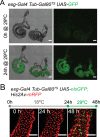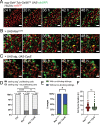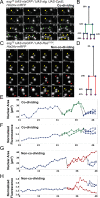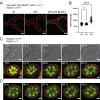An improved organ explant culture method reveals stem cell lineage dynamics in the adult Drosophila intestine
- PMID: 36005292
- PMCID: PMC9578704
- DOI: 10.7554/eLife.76010
An improved organ explant culture method reveals stem cell lineage dynamics in the adult Drosophila intestine
Abstract
In recent years, live-imaging techniques have been developed for the adult midgut of Drosophila melanogaster that allow temporal characterization of key processes involved in stem cell and tissue homeostasis. However, these organ culture techniques have been limited to imaging sessions of
Keywords: D. melanogaster; Drosophila midgut; cell biology; cell lineage; live-imaging; organ culture; stem cells; tissue regeneration.
© 2022, Marchetti et al.
Conflict of interest statement
MM, CZ, BE No competing interests declared
Figures














Similar articles
-
Migration of Drosophila intestinal stem cells across organ boundaries.Development. 2013 May;140(9):1903-11. doi: 10.1242/dev.082933. Development. 2013. PMID: 23571215 Free PMC article.
-
Ubx dynamically regulates Dpp signaling by repressing Dad expression during copper cell regeneration in the adult Drosophila midgut.Dev Biol. 2016 Nov 15;419(2):373-381. doi: 10.1016/j.ydbio.2016.08.027. Epub 2016 Aug 25. Dev Biol. 2016. PMID: 27570230 Free PMC article.
-
A live-imaging protocol for tracking intestinal stem cell divisions in the Drosophila melanogaster pupal midgut.STAR Protoc. 2023 Dec 15;4(4):102749. doi: 10.1016/j.xpro.2023.102749. Epub 2023 Dec 1. STAR Protoc. 2023. PMID: 38041821 Free PMC article.
-
The origin of intestinal stem cells in Drosophila.Dev Dyn. 2012 Jan;241(1):85-91. doi: 10.1002/dvdy.22759. Epub 2011 Oct 3. Dev Dyn. 2012. PMID: 21972080 Review.
-
Intestinal stem cell proliferation and epithelial homeostasis in the adult Drosophila midgut.Insect Biochem Mol Biol. 2015 Dec;67:9-14. doi: 10.1016/j.ibmb.2015.05.016. Epub 2015 May 27. Insect Biochem Mol Biol. 2015. PMID: 26024801 Review.
Cited by
-
The transmembrane protein Syndecan is required for stem cell survival and maintenance of their nuclear properties.PLoS Genet. 2025 Feb 6;21(2):e1011586. doi: 10.1371/journal.pgen.1011586. eCollection 2025 Feb. PLoS Genet. 2025. PMID: 39913561 Free PMC article.
-
Organ injury accelerates stem cell differentiation by modulating a fate-transducing lateral inhibition circuit.bioRxiv [Preprint]. 2025 May 23:2024.12.29.630675. doi: 10.1101/2024.12.29.630675. bioRxiv. 2025. PMID: 39803552 Free PMC article. Preprint.
-
Polyclonality and metabolic heterogeneity in a colorectal tumor model.iScience. 2025 Jul 10;28(8):113090. doi: 10.1016/j.isci.2025.113090. eCollection 2025 Aug 15. iScience. 2025. PMID: 40822358 Free PMC article.
-
Independently paced Ca2+ oscillations in progenitor and differentiated cells in an ex vivo epithelial organ.J Cell Sci. 2022 Jul 15;135(14):jcs260249. doi: 10.1242/jcs.260249. Epub 2022 Jul 19. J Cell Sci. 2022. PMID: 35722729 Free PMC article.
-
Bellymount-pulsed tracking: a novel approach for real-time in vivo imaging of Drosophila abdominal tissues.G3 (Bethesda). 2025 Jan 8;15(1):jkae271. doi: 10.1093/g3journal/jkae271. G3 (Bethesda). 2025. PMID: 39556480 Free PMC article.
References
Publication types
MeSH terms
Substances
Grants and funding
LinkOut - more resources
Full Text Sources
Molecular Biology Databases

